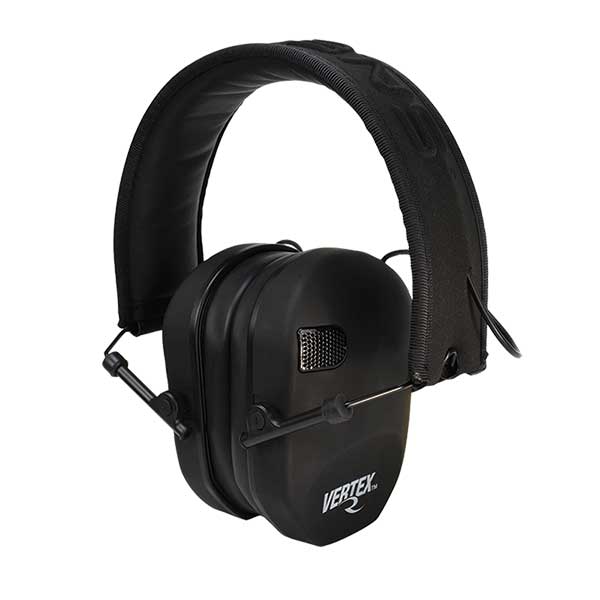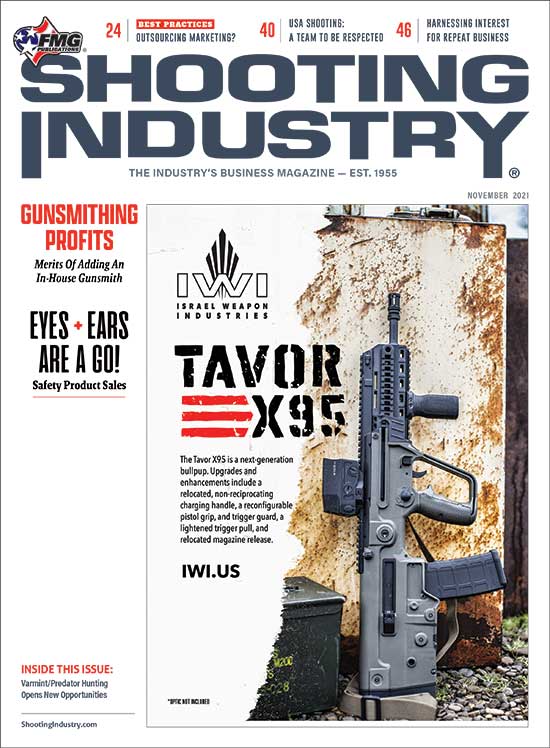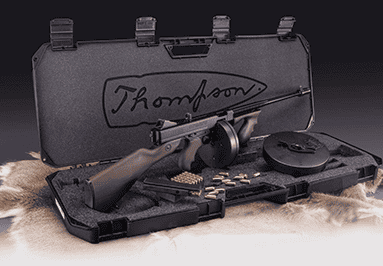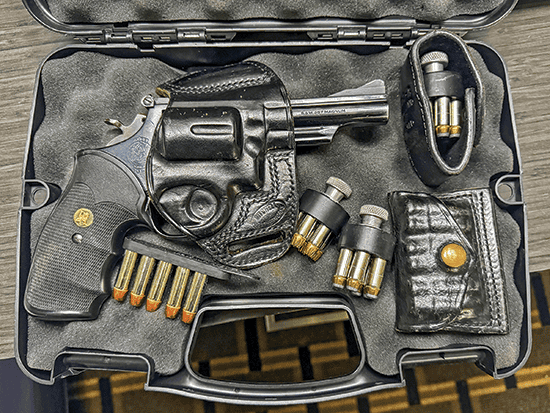Eyes + Ears Are A Go!
Sleek Design, Functionality
Increasingly Important
Forgive me if I get a little personal, but I’m a clear example of what you, as a younger shooter or person selling shooting products never want to become. Namely, nearly deaf — especially in my left ear — with loud tinnitus present 24/7. Repeated exposure to loud noises like shotgun and rifle blasts, rock concerts and even jet engines from my days in the U.S. Air Force all contributed.
Fortunately, subsequent generations seem to have learned they don’t have to foolishly ignore the need for hearing protection, and many capable companies are delivering quality products designed to safeguard shooters indoors and outdoors, at the range or while hunting.
We asked a few retailers for their take on what is happening in the market for shooting protection.
Technology At The Forefront
Kyle Fiest, purchasing manager at Frontier Justice in Lee’s Summit, Mo., (an outfit with two other locations in Kansas and Nebraska), said he’s seeing a general trend of shooters wanting sleeker, more comfortable hearing protection. This especially makes sense for shooters who are hunting or in move-and-shoot scenarios where bulky muffs can interfere with concentration or even shooting form.
Fiest said the industry is moving to an all-in-one style of muff or even in-ear plugs that can enhance hearing, protect hearing and offer Bluetooth capabilities.
“Bluetooth allows them to listen to music, answer calls or even be connected to a range’s communication system for safety,” Fiest said. “Bluetooth capability was once an expensive luxury, but it is getting to be a standard feature and the prices are really coming down.”
Chris Duran is social media manager and a buyer for Turner’s Outdoorsman, which operates 32 stores throughout California and Arizona. He sees the shooting protection category growing, becoming increasingly technology-driven.
“Our customers want a good product to keep them safe and is affordable, technology-driven, comfortable and easy to use,” Duran asserted. “With the pandemic, people are also more aware of personal protection equipment than ever before. I think subsequent years will see even more use and awareness of well-made hearing and eye protection.”
“Shooting has become more mainstream and with this, consumers have become more informed on various products to keep them safe and healthy.”
Chris Duran, Social Media Manager + Buyer Turner’s Outdoorsman Calif. & Ariz.
Turner’s carries more than 100 eye and ear products, about 30 per manufacturer, with Howard Leight, Peltor, Walker leading the assortment, with some Caldwell and Pro Ears mixed in.
Duran is seeing increased awareness of the importance of protection when shooting, noting, “Shooting has become more mainstream and with this, consumers have become more informed on various products to keep them safe and healthy.”
Consumers are also specializing more, not adopting a one-size-fits-all solution to myriad shooting conditions and needs.
“Customers usually want one set of glasses and earmuffs for indoor range use versus outdoor shooting. For indoors they might go with clear glasses and thicker earmuffs, and sometimes double up with an earplug,” Duran said. “When shooting outdoors, however, they may go with a slim muff and tinted glasses.”
He said his bestselling muff is the Howard Leight Impact Sport.
“Not only has it been an amazing product for us, but the world over, it’s the number-one selling earmuff of all time. It checks a lot of boxes, such as being slim enough to use with a shotgun. It’s technology-driven, comfortable and functional, has a good design and appearance and it’s affordable,” Duran said.
A Catch-22
Paul Mangelos of Barnwood Arms in Ripon, Calif., carries about 25 SKUs in his store from Howard Leight, Radians and Sperian. He said sales trends lean heavily toward slim-line electronic muffs like the Impact Sport. Selling foam plugs, though, is always part of a potential sale.
“If a shooter shows interest in wanting more decibel reduction, we recommend the use of plugs in conjunction with muffs,” Mangelos said.
Fiest believes it will be a challenge for manufacturers to improve the dB or NRR rating with the consumer demand for smaller, sleeker earmuffs — a classic catch-22.
“I feel like this is one of the categories that hasn’t made much recent progress — the hearing protection itself,” he noted.
While muffs tend to be affordable and mostly functional and comfortable, and most in-ear hearing protection in the past was simple foam inserts, it could be evolving. A few companies make relatively expensive in-ear hearing and protection devices for the sporting market, most selling direct to consumers. But Fiest sees a big future for electronic in-ear hearing protection.
“We’re starting to see more offerings of electronic earbuds serving as hearing enhancers, hearing protection and have Bluetooth features.”
Kyle Fiest, Purchasing Manager Frontier Arms Lee’s Summit, Mo.
“The same features modern electronic earmuffs have are becoming more common with in-ear, plug-style hearing protection,” Fiest said. “We’re starting to see more offerings of electronic earbuds serving as hearing enhancers, hearing protection and have Bluetooth features. These are still priced higher compared to earmuffs with the same features, but I believe the price will come down considerably in the next few years.”
Fiest notes these in-ear options are especially popular with shooters using rifles or shotguns since they don’t interfere with the firearm’s stock like muffs often do.
“They’re also lighter weight, easier to wear with glasses and hats and they’re generally more comfortable to wear all day. They also don’t trap sweat,” he added.
Offering one final look into the future, Fiest said he also detects a shift toward USB-rechargeable ear protection instead of battery powered.
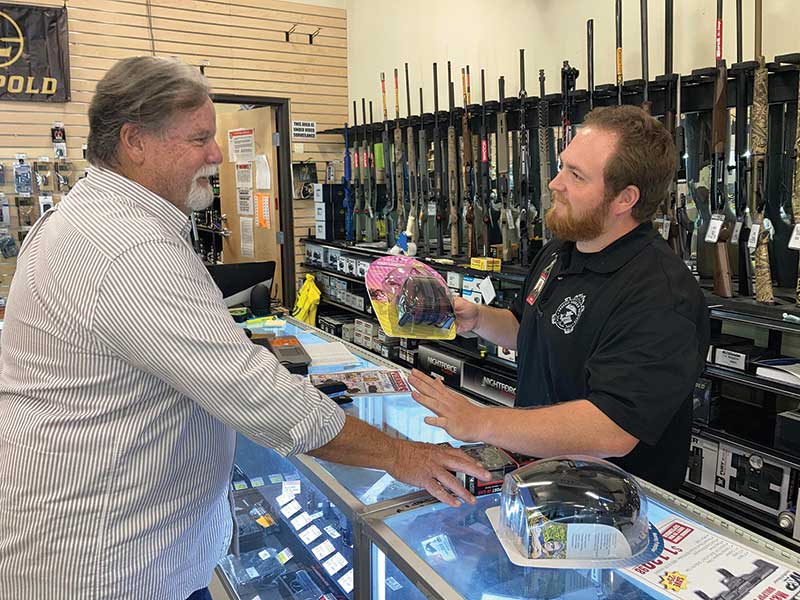
Ben Maier, an assistant store manager for Turner’s Outdoorsman–Lake Forest, runs through the selling
points of various hearing-protection products with a customer. Features once considered a luxury, like
Bluetooth capabilities, are standard today thanks to technological advancements in the category.
Selling It!
Duran outlined Turner’s approach to market research into customer desires, especially as it pertains to ear/eye protection.
“Manufacturers supply us with overall sales history and market research. We then combine it with our sales history and, together, those two things help us make informed buying decisions for our customers. We also consider trending products and topics on various social media platforms and internet forums,” he said.
Consumers are increasingly savvy when it comes to technologically oriented products such as electronic muffs or in-ear electronics. Duran said social media and the internet feed consumers a steady diet of information. Turner’s approach is to focus on training while also hiring the right people, especially those who actively use the products they sell.
Duran sees customers as being willing to “trade up” when products appear with new features, improvements or technologies but declared: “The features and benefits have to justify the cost. As these items can be somewhat disposable, they sell best when the right combination of features and price is achieved.”
Besides the information component, Duran sees manufacturers stepping up their game when it comes to packaging these tools, getting them to stand out.
“More than ever, the packaging and merchandising of these products contains an incredible amount of information with regard to the proper usage and safety rating of each item,” Duran said.
While hearing-protection tools aren’t necessarily expendable, they do get lost, damaged or simply wear out. Some items, like electronic muffs, often have replacement components, such as the pads that fit snug to your face. Fit and function are, after all, essential to eye and ear protection.
“This category is definitely growing as more and more shooters are venturing out to ranges and competitions,” Duran concluded. “While there are some replacement components for things like electronic earmuffs, products that come in contact with the human body can become less effective over time and need to be replaced in order to keep people truly safe and healthy.”
Make sure your words don’t fall on deaf ears: Assert your knowledge and use the products at your disposal to emphasize the importance of vision and hearing protection where firearms are concerned. Provided they listen, it will always lead to customer trust and loyalty.





